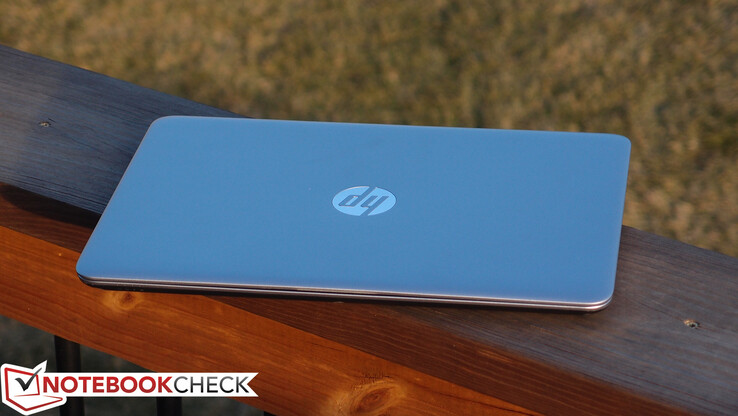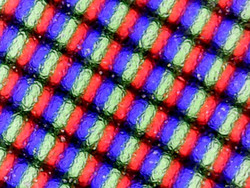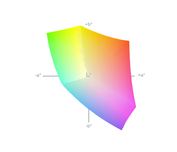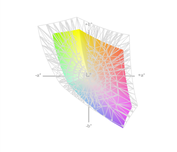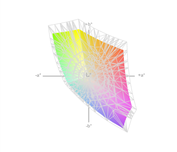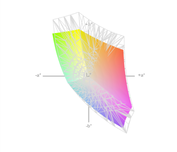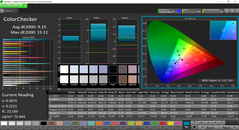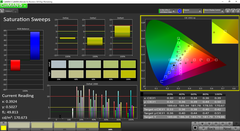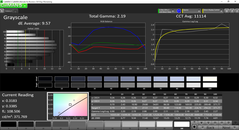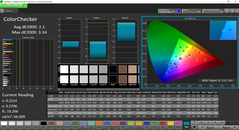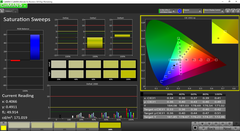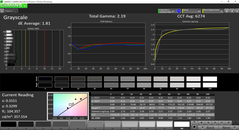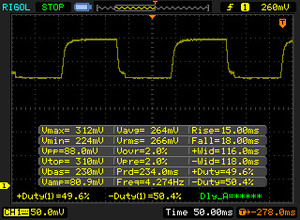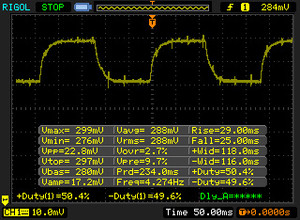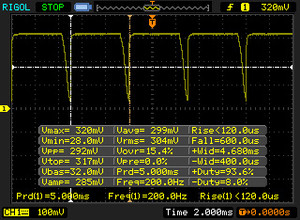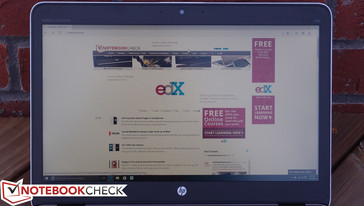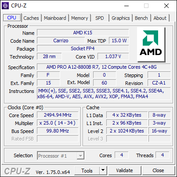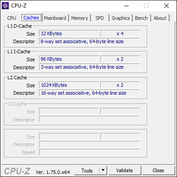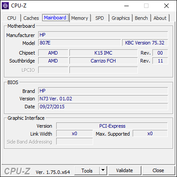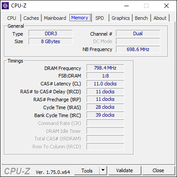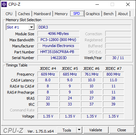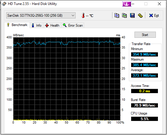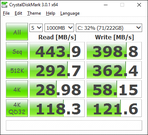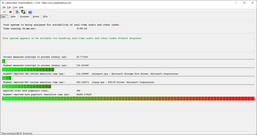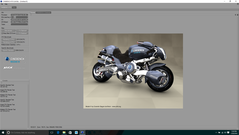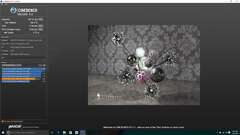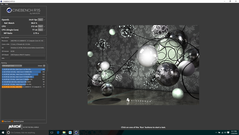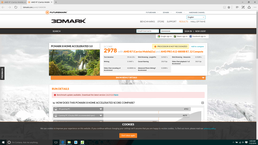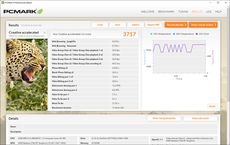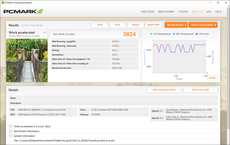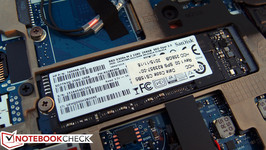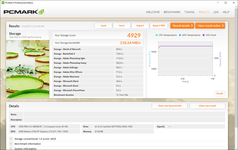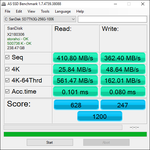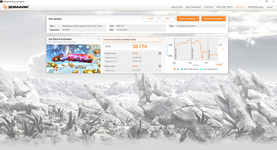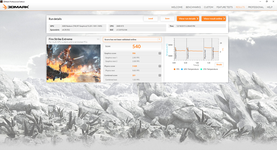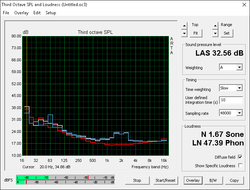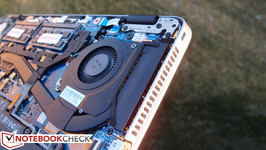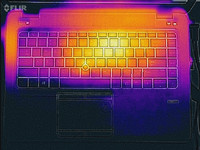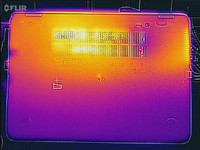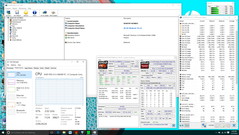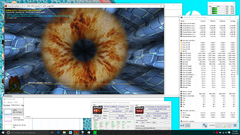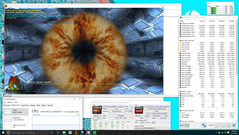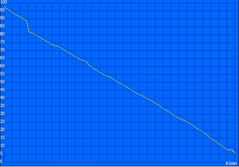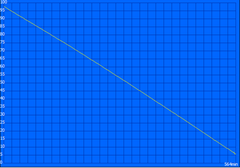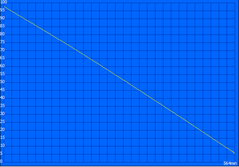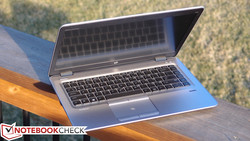HP EliteBook 745 G3 (FHD) Notebook Review

Owing primarily to the resilience of the market segment, there is no shortage of available premium-grade 14-inch business notebooks. The smorgasbord of options from Dell, Lenovo, HP, and other manufacturers generally features two major points of consistency: the cost is high, and the chipset is from Intel. But as we explained in last week’s HP EliteBook 745 G3 (German) review, this is a notebook which seeks to challenge both of these conventions with a more affordable price point and AMD Pro processors inside.
Since we’ve already covered much of the basics regarding the EliteBook 745 G3 in previous reviews, our evaluation of today’s configuration will primarily consist of another look at the overall performance numbers (as it applies to the slightly different components in our current unit), as well as an in-depth evaluation of the 1080p display panel as it compares with last week’s superior (and considerably more expensive) WQHD option. There are some other minor differences, too, which we’ll detail in the course of this review.
Apart from the 1080p panel, today’s configuration also features an AMD Pro A12-8800B APU with Radeon R7 (Carrizo) Graphics, 8 GB of dual-channel DDR3-1600 RAM, and a 256 GB SSD. It retails for $1,049 MSRP, which is well below that of most of its rivals, and roughly $150 MSRP lower than the WQHD screen configurations. Let’s see how it stacks up.
Preliminary Summary/Differences
Please reference last week’s EliteBook 745 G3 review, as well as our preceding EliteBook 745 G2 review, for much more detail on the particulars of the machine’s design, casing, input devices, and other common components, as the machines are practically identical in this regard.
The biggest benefit of today’s $1,049 configuration is that the primary components that render the rest of the EliteBook 745 models worthwhile are retained, even in spite of the loss of the higher-grade display panel. We still receive a fully metal casing that feels relatively rigid, good hinges, great input devices (including arguably one of the best keyboards of any Ultrabook), and a very manageable weight of just around 1.55 kg (3.41 lbs). The same complaints still apply, however—most notably, the unnecessarily cumbersome upgrade/maintenance process thanks to the numerous screws securing the bottom panel. The casing, also, while sturdy enough, does not seem to quite compare to the rigidity of, say, a Dell Latitude E7450 or Lenovo ThinkPad T450s. But again, it is still very good overall, and the cost here is quite a bit lower.
Display
The display is the biggest difference between our previous review model and this one. Whereas our last test candidate sported a 14-inch 2560x1440 IPS panel with good color gamut and great brightness and contrast, today’s configuration features a lower-end (and much lower-cost) 1080p (1920x1080) TN panel. Nevertheless, that’s still 157 PPI, which is perfectly sufficient pixel density for any business user, and far better than the lowest-end 768p option. It’s still fortunately anti-glare, and subjectively speaking, it seems quite bright. However it isn’t nearly as vivid or as attractive as the WQHD setup.
| |||||||||||||||||||||||||
Brightness Distribution: 89 %
Center on Battery: 366.2 cd/m²
Contrast: 513:1 (Black: 0.714 cd/m²)
ΔE ColorChecker Calman: 9.15 | ∀{0.5-29.43 Ø4.77}
ΔE Greyscale Calman: 9.57 | ∀{0.09-98 Ø5}
77.28% sRGB (Argyll 1.6.3 3D)
49.03% AdobeRGB 1998 (Argyll 1.6.3 3D)
52.6% AdobeRGB 1998 (Argyll 3D)
76.7% sRGB (Argyll 3D)
50.9% Display P3 (Argyll 3D)
Gamma: 2.19
CCT: 11114 K
| HP EliteBook 745 G3 14", 1920x1080 | HP EliteBook 745 G3 14", 2560x1440 | Dell Latitude E7450 14", 1920x1080 | Lenovo ThinkPad T450s-20BWS1UT00 14", 1920x1080 | Toshiba Portege Z30t-B1320W10 13.3", 1920x1080 | |
|---|---|---|---|---|---|
| Display | 39% | 27% | 17% | 30% | |
| Display P3 Coverage (%) | 50.9 | 75.7 49% | 66.6 31% | 64.8 27% | 67.1 32% |
| sRGB Coverage (%) | 76.7 | 95.8 25% | 92.4 20% | 83.8 9% | 96.8 26% |
| AdobeRGB 1998 Coverage (%) | 52.6 | 74.5 42% | 67.7 29% | 61.2 16% | 68.9 31% |
| Response Times | 19% | -32% | |||
| Response Time Grey 50% / Grey 80% * (ms) | 54 ? | 46.8 ? 13% | 59.2 ? -10% | ||
| Response Time Black / White * (ms) | 33 ? | 25.2 ? 24% | 50.4 ? -53% | ||
| PWM Frequency (Hz) | 200 ? | 215.5 | |||
| Screen | 27% | 27% | 31% | 35% | |
| Brightness middle (cd/m²) | 366.2 | 319 -13% | 280 -24% | 288 -21% | 296.1 -19% |
| Brightness (cd/m²) | 343 | 301 -12% | 257 -25% | 281 -18% | 284 -17% |
| Brightness Distribution (%) | 89 | 74 -17% | 75 -16% | 94 6% | 90 1% |
| Black Level * (cd/m²) | 0.714 | 0.29 59% | 0.3 58% | 0.286 60% | 0.308 57% |
| Contrast (:1) | 513 | 1100 114% | 933 82% | 1007 96% | 961 87% |
| Colorchecker dE 2000 * | 9.15 | 7.23 21% | 3.45 62% | 4.35 52% | 3 67% |
| Colorchecker dE 2000 max. * | 15.11 | ||||
| Greyscale dE 2000 * | 9.57 | 6 37% | 3.35 65% | 3.7 61% | 1.61 83% |
| Gamma | 2.19 100% | 2.14 103% | 2.37 93% | 2.68 82% | 2.18 101% |
| CCT | 11114 58% | 6904 94% | 6940 94% | 6076 107% | 6716 97% |
| Color Space (Percent of AdobeRGB 1998) (%) | 49.03 | 65.8 34% | 60 22% | 54.7 12% | 62.37 27% |
| Color Space (Percent of sRGB) (%) | 77.28 | 95.3 23% | 92 19% | 96.57 25% | |
| Total Average (Program / Settings) | 28% /
29% | 27% /
27% | 24% /
27% | 11% /
24% |
* ... smaller is better
The average brightness of 343.1 cd/m² is superior to that of all of the closest competitors, including the WQHD screen configuration. On the other hand, the contrast of just 513:1 is nothing special, and is less than half that of the rest of the field. Of course, it might be more accurate to compare these results with the low-end 768p models from the competition given the differences in price point, but that depends on your perspective.
We measured 77% coverage of the sRGB spectrum (and just 49% of AdobeRGB), which is considerably lower than the 95% and 66% (respectively) of the WQHD panel, and once again lower than all of the competing models (see our table for more details). That’s still not a terrible color gamut in the grand scheme of things, especially in the realm of business machines—but it’s a far cry from the best panels. Most business users aren’t likely to mind, but anyone doing any degree of photography work should opt for the better screen.
Telling the other half of the story is CalMAN, in which we measured a ColorChecker DeltaE2000 average of 9.15—which is quite bad indeed. This is a panel badly in need of calibration; afterwards, we measured a value of 2.1, which is completely reasonable. The same goes for the grayscale DeltaE, which began at 9.57 and was later tamed to 1.81. On the other hand, the Total Gamma of 2.19 is just about spot-on (with an ideal value of 2.2).
Another major divergence from the brilliance of the WQHD panel is the incidence of PWM on the 1080p model at all brightness settings other than maximum. That’s a problem for anyone who is sensitive to the flickering—those users would certainly be better off paying the $150 premium for the higher-end screen, which does not exhibit these symptoms.
Display Response Times
| ↔ Response Time Black to White | ||
|---|---|---|
| 33 ms ... rise ↗ and fall ↘ combined | ↗ 15 ms rise | |
| ↘ 18 ms fall | ||
| The screen shows slow response rates in our tests and will be unsatisfactory for gamers. In comparison, all tested devices range from 0.1 (minimum) to 240 (maximum) ms. » 89 % of all devices are better. This means that the measured response time is worse than the average of all tested devices (20.2 ms). | ||
| ↔ Response Time 50% Grey to 80% Grey | ||
| 54 ms ... rise ↗ and fall ↘ combined | ↗ 29 ms rise | |
| ↘ 25 ms fall | ||
| The screen shows slow response rates in our tests and will be unsatisfactory for gamers. In comparison, all tested devices range from 0.165 (minimum) to 636 (maximum) ms. » 90 % of all devices are better. This means that the measured response time is worse than the average of all tested devices (31.6 ms). | ||
Screen Flickering / PWM (Pulse-Width Modulation)
| Screen flickering / PWM detected | 200 Hz | ≤ 90 % brightness setting | |
| ≤ 343 cd/m² brightness | |||
The display backlight flickers at 200 Hz (worst case, e.g., utilizing PWM) Flickering detected at a brightness setting of 90 % (343 cd/m²) and below. There should be no flickering or PWM above this brightness setting. The frequency of 200 Hz is relatively low, so sensitive users will likely notice flickering and experience eyestrain at the stated brightness setting and below. Flickering occurs even at high brightness setting and may have an effect on the user during everyday use. In comparison: 53 % of all tested devices do not use PWM to dim the display. If PWM was detected, an average of 8081 (minimum: 5 - maximum: 343500) Hz was measured. | |||
Outdoors, the only thing working against the EliteBook 745 G3 is the weak contrast ratio. The rest of the panel’s attributes—most notably the very good brightness—make for a comfortable picture in nearly any scenario apart from direct sunlight. Viewing angles are narrow and restrictive, with vertical deviance especially quickly washing out the picture.
Performance
The internal specifications of the EliteBook we’re reviewing today are nearly identical to those of last week’s WQHD model. However, we’ll be revisiting some of the details nonetheless for comparative purposes. Although configurations range widely in terms of display panel options, the biggest decisions to be made with regard to performance are how much RAM and storage is included (both of which, of course, can be upgraded later relatively easily).
Both the previous test machine and our current one feature an AMD Pro A12-8800B CPU. One difference, however, is that our machine came with 8 GB of dual-channel DDR3 1600 MHz RAM installed (2 x 4 GB SODIMMs) versus the single-channel 8 GB configuration we received in the last unit. However, we performed most of our graphics testing in that review with a secondary 8 GB stick installed, so the results are not expected to change much here.
Apart from a couple of outliers, performance on the whole is—as expected—very much similar to the previous model we reviewed. That is to say, below comparable mainstream business models from other rivals. Let’s step through each individual section as usual here for some quick analysis of what’s going on. Keep in mind that for much more comparison and analysis of any of these items (except where otherwise noted), you can reference our previous review of the EliteBook 745 G3.
Processor
The AMD Pro A12-8800B is a complex SoC with two Excavator CPU modules (4 compute cores) paired with a Radeon R7 graphics adapter featuring 8 compute cores. This chip is constructed using a 28 nm architecture, carrying a TDP of 15 W. As we noted in our last review, although this CPU is roughly 30% faster than the previous A10 Pro-7350B, while running within the constraints of 15 W TDP, it’s not much different from an A10-8700P. We noted how the power limitations affected clock speeds during our tests: we witnessed constant fluctuation between 2.5 and 3.4 GHz in single-threaded benchmarks, whereas multi-threaded tests saw an eventual drop from a 2.5 GHz max down to just 2.1 GHz on our machine—disappointing.
Obviously, not much has changed here, and the same issues apply. The CPU is notably slower than even an Intel Core i3-6100U, so in spite of the acceptable overall system performance, this is hardly any sort of conquering triumph for AMD. As compared with the Dell Latitude E7450, Lenovo ThinkPad T450, and Toshiba Portege Z30t, the EliteBook 745 G3 is eclipsed by anywhere from 38 to 117 percent in the three Cinebench 64-bit single-threaded benchmarks, and beaten by between 7 and 80 percent in the multi-threaded tests. Take a look at our table below for much more detail on how this breaks down.
| Cinebench R10 | |
| Rendering Single CPUs 64Bit (sort by value) | |
| HP EliteBook 745 G3 | |
| HP EliteBook 745 G3 | |
| Dell Latitude E7450 | |
| Lenovo ThinkPad T450s-20BWS1UT00 | |
| Toshiba Portege Z30t-B1320W10 | |
| Rendering Multiple CPUs 64Bit (sort by value) | |
| HP EliteBook 745 G3 | |
| HP EliteBook 745 G3 | |
| Dell Latitude E7450 | |
| Lenovo ThinkPad T450s-20BWS1UT00 | |
| Toshiba Portege Z30t-B1320W10 | |
System Performance
But, fortunately for AMD (and the EliteBook 745 G3), CPU performance isn’t the whole story. General system performance is of much greater consequence for the average business user, and here, the EliteBook looks completely different. With a PCMark 7 score of 4729 points and a PCMark 8 Work Score Accelerated of 3824 points, there is little reason to doubt that the laptop can handle the typical demands of the workday. The competing machines are just around 5 to 10 percent faster than the 745 G3 here, which is of much less concern.
Curiously, these scores are 28 and 10 percent higher than those of last week’s 745 G3 configuration, and the reason for this is likely quite simple: that machine featured a Samsung PM851 SSD—which is known for its mild deficiency in sequential write speed—whereas today’s includes a SanDisk X300s SSD. We’ll explore the storage benchmarks in the next section, but suffice it to say that this remains a major factor in the overall perceived speed of a machine’s operations.
| PCMark 7 - Score (sort by value) | |
| HP EliteBook 745 G3 | |
| HP EliteBook 745 G3 | |
| Dell Latitude E7450 | |
| Lenovo ThinkPad T450s-20BWS1UT00 | |
| Toshiba Portege Z30t-B1320W10 | |
| PCMark 7 Score | 4729 points | |
| PCMark 8 Home Score Accelerated v2 | 2978 points | |
| PCMark 8 Creative Score Accelerated v2 | 3717 points | |
| PCMark 8 Work Score Accelerated v2 | 3824 points | |
Help | ||
Storage Devices
Taking a closer look at the SanDisk X300s confirms our suspicions: with an AS SSD score of 1200 points, it’s head and shoulders above the Samsung PM851’s 821 points. The primary determinant here is the 4K-64 read speed differential (561.47 MB/s versus 260.87 MB/s) and the aforementioned write speed discrepancies (362.4 MB/s versus 259.41 MB/s).
One thing worth noting about the EliteBook 745 G3’s storage configuration is that our unit came with an M.2 SSD, leaving an open 2.5-inch storage bay (7mm height) to be populated later by a secondary storage device. This opportunity for a dual-storage setup actually places the EliteBook above the Latitude E7450, which sacrifices the mSATA capabilities of its predecessor and lacks an M.2 slot. In terms of 14-inch business notebooks with dual-storage capability, the EliteBook is certainly one of the most affordable.
GPU Performance
Firstly, we should note: the comparisons shown here on our graph are with the single-channel memory configuration of the EliteBook 745 G3; we did not include the adjusted results following our addition of the second SODIMM. However, the results here are even better than before (albeit marginally), with a score of 2020 in 3DMark 11 and 1170 in 3DMark Fire Strike Standard (versus our previous results of 1845 and 1153, respectively). Of course, as we mentioned previously, the existence of the second stick of memory (to make it dual-channel) provides a substantial overall boost to GPU performance—roughly 30 to 35 percent in this case.
Don’t miss our previous review of the machine for tons of game benchmarks and more analysis of the performances differences between single- and dual-channel memory configurations.
| 3DMark 11 - 1280x720 Performance (sort by value) | |
| HP EliteBook 745 G3 | |
| HP EliteBook 745 G3 | |
| Dell Latitude E7450 | |
| Lenovo ThinkPad T450s-20BWS1UT00 | |
| Toshiba Portege Z30t-B1320W10 | |
| 3DMark | |
| 1920x1080 Fire Strike Score (sort by value) | |
| HP EliteBook 745 G3 | |
| HP EliteBook 745 G3 | |
| Dell Latitude E7450 | |
| Lenovo ThinkPad T450s-20BWS1UT00 | |
| Toshiba Portege Z30t-B1320W10 | |
| 1280x720 Cloud Gate Standard Score (sort by value) | |
| HP EliteBook 745 G3 | |
| HP EliteBook 745 G3 | |
| Dell Latitude E7450 | |
| Lenovo ThinkPad T450s-20BWS1UT00 | |
| Toshiba Portege Z30t-B1320W10 | |
| 1280x720 Ice Storm Standard Score (sort by value) | |
| HP EliteBook 745 G3 | |
| HP EliteBook 745 G3 | |
| Dell Latitude E7450 | |
| Lenovo ThinkPad T450s-20BWS1UT00 | |
| Toshiba Portege Z30t-B1320W10 | |
| 3DMark 06 Standard Score | 7857 points | |
| 3DMark 11 Performance | 2020 points | |
| 3DMark Ice Storm Standard Score | 45140 points | |
| 3DMark Cloud Gate Standard Score | 5005 points | |
| 3DMark Fire Strike Score | 1170 points | |
| 3DMark Fire Strike Extreme Score | 540 points | |
Help | ||
Emissions
System Noise
In terms of fan noise, there isn’t much to complain about with regard to the EliteBook. Today’s measurements revealed across-the-board lower values versus even our previous ones, and tangibly lower noise levels (9% and 11% respectively) than the Dell Latitude E7450 and Toshiba Portege Z30t. However, that’s only half the story: unfortunately, our review unit exhibited an obtrusive level of CPU whine, which is evident anytime the machine is processing a consistent load. This is only likely to really bother those with fairly good hearing, but our editor today found it difficult to ignore in a quiet room.
| HP EliteBook 745 G3 Radeon R7 (Carrizo), Pro A12-8800B, SanDisk X300s SD7TN3Q-256G-1006 | HP EliteBook 745 G3 Radeon R7 (Carrizo), Pro A12-8800B, Samsung SSD PM851 256 GB MZNTE256HMHP | Dell Latitude E7450 HD Graphics 5500, 5300U, Samsung SSD PM851 mSATA 128 GB | Lenovo ThinkPad T450s-20BWS1UT00 GeForce 940M, 5200U, Samsung SSD PM871 MZ7LN256HCHP | Toshiba Portege Z30t-B1320W10 HD Graphics 5500, 5600U, Toshiba THNSNJ256GMCU | |
|---|---|---|---|---|---|
| Noise | -8% | -9% | -4% | -11% | |
| Idle Minimum * (dB) | 28.5 | 29 -2% | 29.1 -2% | 29.1 -2% | 30.2 -6% |
| Idle Average * (dB) | 28.6 | 29 -1% | 29.1 -2% | 29.1 -2% | 30.3 -6% |
| Idle Maximum * (dB) | 28.6 | 31.1 -9% | 30 -5% | 29.1 -2% | 32.2 -13% |
| Load Average * (dB) | 30.5 | 35.6 -17% | 36.4 -19% | 33.1 -9% | 35.6 -17% |
| Load Maximum * (dB) | 32.6 | 35.6 -9% | 37.8 -16% | 34.3 -5% | 37.6 -15% |
* ... smaller is better
Noise level
| Idle |
| 28.5 / 28.6 / 28.6 dB(A) |
| Load |
| 30.5 / 32.6 dB(A) |
 | ||
30 dB silent 40 dB(A) audible 50 dB(A) loud |
||
min: | ||
Temperature
Oddly enough, even under the same temperature, we measured palpably different average temperatures between our previous 745 G3 review and this one. Here, the machine is a couple degrees cooler in nearly every scenario, which is odd, but welcomed. While idle, we measured just 26 °C and 28.1 °C on top and bottom, whereas under load, those values climb to 29.6 °C and 32.8 °C—still nothing at all to be concerned about. The sole hotspot in the top-center quadrant of the underside of the machine reached a somewhat uncomfortable 43.8 °C, but the fact that none of the surrounding regions even surpassed 37 °C communicates the machine’s effective cooling strategy.
(+) The maximum temperature on the upper side is 36.8 °C / 98 F, compared to the average of 34.3 °C / 94 F, ranging from 21.2 to 62.5 °C for the class Office.
(±) The bottom heats up to a maximum of 43.8 °C / 111 F, compared to the average of 36.8 °C / 98 F
(+) In idle usage, the average temperature for the upper side is 26 °C / 79 F, compared to the device average of 29.5 °C / 85 F.
(+) The palmrests and touchpad are cooler than skin temperature with a maximum of 26 °C / 78.8 F and are therefore cool to the touch.
(±) The average temperature of the palmrest area of similar devices was 27.6 °C / 81.7 F (+1.6 °C / 2.9 F).
Stress Test
During our full CPU stress test, the Elitebook 745 G3 began briefly at 2.5 GHz before dropping to just 2.1 GHz (with occasional hiccups to an even lower 1.7 GHz) after around half an hour of stress with Prime95. That’s a pretty disappointing performance which is spearheaded by the low TDP of 15 W. Clearly, HP is choosing power efficiency (and thus battery live) over performance here. Still, it’s a major sacrifice by some measurements which further highlights the gap between the modern Intel chips and their AMD counterparts.
On the GPU side, we never witnessed anything close to the maximum 800 MHz clock rate of which this SoC is capable. Instead, the GPU hovered closer to 315 MHz for the duration of the test, again hampered by TDP. Adding in CPU stress predictably only reduces it further: while the CPU throttled to 1.4 GHz, the GPU stayed put at just 300 MHz. We never once witnessed CPU core temperatures anywhere about 54 °C, so thermals absolutely are not a concern.
Speakers
The EliteBook’s speakers are certainly a notch above the category average, but they’re still not in the same ballpark as Dell’s Latitude E7450, which (somehow) produces sound that actually rivals that of some multimedia notebooks. Still, the clarity of the tiny drivers is commendable, with crisp highs and hardly any distortion to be spoken of. Lows are another story, of course: there’s barely any bass to behold, no matter what settings or presets you choose. Still, the Bang & Olufsen DTS Studio Sound post-processing software does yield some authentic benefits.
Battery Life
Although our new results are still hardly great, the EliteBook 745 G3 posted far better battery life results this time around as compared with the disappointing numbers we saw coming out of our WQHD model review. The previous unit posted a Load value of just 1 hour and 16 minutes, an Idle value of 7:22, and—most distressingly—a WiFi Surfing v1.3 time of 3:07. That result is well below most other business notebooks, and is quite frankly inadequate. Instead, today’s machine managed 1:21 under load, lasted for 9:24 while idle, and clocked a much more reasonable 5:39 while surfing.
The differences here are most likely attributable to both a lower display panel power consumption (WQHD versus 1080p resolution) and possibly better power management under Windows 10. Still, these results are far below the likes of the Latitude E7450 (7:02), the Portege Z30t (7:46), and especially, the ThinkPad T450s (10:48). Once again, the efficiency of Intel’s latest offerings carves a wide ravine between notebooks powered by their chips versus those from AMD.
Pros
Cons
Verdict
Last week’s review of the HP EliteBook 745 G3 opened the conversation regarding a lower-cost alternative to the typical high-priced business notebooks. Since it retains much of the EliteBook 800 series design highlights, the 745 G3 reaps many of the relevant benefits that help to make that a top-tier competitor in the business segment. However, sporting AMD Pro components rather than Intel, the cost is considerably lower than most other competitors. Today’s unit takes that strategy a step further with a cheaper display panel that drops the total cost to just $1,049 MSRP. In spite of this, the EliteBook 745 G3 still grants you a terrific keyboard and great touchpad, attractive and rigid casing, quick general performance, flexible maintenance, and a great warranty.
The biggest advantage of this EliteBook 745 G3 configuration is the opportunity to sacrifice some degree of processing performance and battery life—as well as screen quality—in exchange for a business machine with all the rest of the typical sensibilities for a considerably lower cost.
Where the rest of the compromises arise is, as before, in the realms of processing performance and battery life. Hampered notably by a 28 nm architecture, AMD’s latest APUs—while much improved and certainly offering enticing benefits in the way of graphical capability—still cannot compete with the highly efficient top-grade offerings from Intel. Whether this is of concern to the average business consumer, on the other hand, is a different question entirely. For those who spend much of the day near a power outlet and whose activities primarily consist of general business tasks, the EliteBook 745 G3 might seem like a rational compromise.
HP EliteBook 745 G3
- 01/28/2016 v4.1 (old)
Steve Schardein


